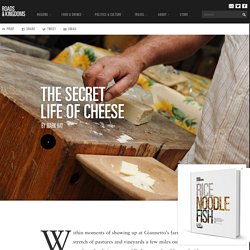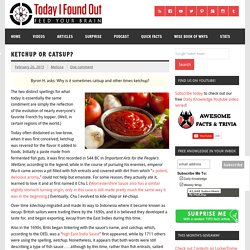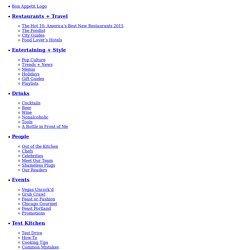

History of the Launch of Epicurious in 1995. When we launched two decades ago, the Internet was still a tiny, painfully slow place.

It even had a different name. Back in 1995, we were the first recipe website. Back in 1995, we were the first recipe website. (Or close enough.) One minute, there were no recipes online. Lucky Peach. MUNCHIES. Tom Hertweck, "Food on Film" (Rowman and Littlefield, 2014) What breakfast looks like around the world. The Secret Life of Cheese. We all got to take a bite out of our kid’s bloody, hot, raw liver and it was young enough that it had only milk in its stomach, but unfortunately, it also had a tapeworm, eliminating it as a candidate for cheese production.

However, Giannetto assures me that in one of his many little barns, past legs of peppered prosciutto and slabs of fatty cheek, there’s a rafter strung up with a good handful of caligù, a batch of which is ready to be consumed. And later that night, after we’ve put away our fair share of goat flesh, flatbread, baked cheese and fresh honey, tomatoes and cucumbers, and homebrew booze, he suddenly materializes one of the brown-red, triangular batches. Ketchup or Catsup? Byron H. asks: Why is it sometimes catsup and other times ketchup?

The two distinct spellings for what today is essentially the same condiment are simply the reflection of the evolution of nearly everyone’s favorite French fry topper. (Well, in certain regions of the world.) Best of the Wurst: 19 German sausages to love. Google Employees Will Soon Eat From a Fleet of Artisanal… And it's all free, of course.

Job perks abound when you work for tech giant Google — hello, massage chairs and sleep pods — and here's yet another one: Employees at the Mountain View, Calif. headquarters will soon be able to snag free lunch from a battalion of 20 food trucks parked on campus, reports Business Insider. These will not be mere taco and coffee trucks, either: The company behind the trucks, a mobile catering venture called The Whole Cart, says all 20 are brand-new concepts intended to "fulfill Google's food standards — responsible sourcing, portion size, and a plant-centric diet — as well as uphold the artisanal culture food trucks are known for.
" 9 ways personality influences your taste preferences. Can’t help but cram sky diving, hang gliding or bungee jumping into your weekend?

A study from Penn State says thrill seekers are more apt to flirt with setting their mouth on fire by digging into fiery foods than those who are mild-mannered or passive. The scientists speculate that capsaicin, the compound that gives hot peppers their zing, links your taste buds’ passion for peppers and an adrenaline rush, and that eating foods with capsaicin can simulate the rush of living on the edge. “You take the risk that hot peppers and similar foods will burn your mouth, just like you risk your life sky diving,” says Keith Kantor, a nutritionist and author of “What Matters: Leadership Values That Just Might Save America.” Kantor says hot-pepper lovers are also usually more tolerant of change than other people.
How To Sharpen Your Knives The Right Way. Why It's Really, Really Important To Slice Meat Against The Grain. The Birth of Saké. The Food Capitals of Instagram. The Secret Stories of Star Wars Foods. Do Klatooine paddy frogs pair better with bantha milk or Jawa juice?

And what’s good to eat on a swamp planet where the only chef is a tiny green Jedi hermit? As richly detailed as the Star Wars universe is, food takes a back seat to all the explosions and dramatic lightsaber duels. Everything You Need to Know About Circus Peanuts. While Circus Peanuts are not as popular as they were during the day of the famous "penny candies," many Americans — especially older generations — are familiar with the sweet banana-flavored treat.

Here is everything you need to know about the bite-sized snack with a love-it-or-hate-it reputation. What are circus peanuts? While this shouldn't come as a shock, circus peanuts are not real peanuts. Rather, they are a peanut-shaped marshmallow candy with a soft and spongy texture. The most popular modern variety is orange in color and comes in an artificial banana flavor. What ingredients go into them? Sake Isn't a Rice Wine, and Four Other Myths Dispelled. Sake is more popular than ever before in the U.S., and due to continually increasing exports, our country now enjoys the largest and highest quality selection in history.

While it’s great to have an abundance of sake choices, this fermented rice drink is still somewhat misunderstood. Below, five common sake beliefs, debunked. 1) Only cheap, low quality sakes are served hot Whether sake sould be served warm versus chilled is hotly disputed. When sake first became available in the U.S., many early imbibers experienced it as a no-name piping hot house sake. Everything You Need to Know About Chiles and Other Vectors of Hotness. Not the physical type of heat, but the heat that derives from chiles or black peppercorns, producing a sensation somewhere on a continuum from warm mellowness to outright pain.

English — with its dearth of food words — is incapable of accurately distinguishing such a sensation from physical heat, calling a chile-laden dish "hot," even though burning your mouth with chiles is entirely different than burning your mouth with hot coffee. Burning your mouth with chiles is entirely different than burning it with hot coffee In fact, there’s not one but several types of gastro-heat. Now coming to food trucks: high-end Spam. In times of economic trouble, Spam flies off the shelves.

But now, as the economy improves, Hormel Foods’ canned pre-cooked pork is looking for a new, higher-brow market. The product has played a bit part in “haute” cuisine since at least 2009, when Vinny Dotolo of the LA eatery Animal paired it with foie gras. In 2011, chef Hooni Kim put it in a stew at his New York restaurant Danji. Last April, Gothamist reported that New York Sushi Ko included Spam fried rice on a $135 tasting menu. Today's Google Doodle Honors Instant Noodle Inventor Momofuku Ando. Today would have been the 105th birthday of Momofuku Ando, inventor of instant ramen and Cup Noodles, the college dorm room staple, and one of the quickest meals known to modern man. Ando, a Taiwanese-Japanese businessman, founded Nissin Food Products Co., Ltd. in 1958. By that time, he was in his 40s. The Beginnings of Ivan Ramen. This feature originally appeared in “Lucky Peach #1: Ramen.” Pick up a subscription here! The Keio Line originates in the skyscraper garden of Shinjuku and runs several hours west, through the suburbs and into the countryside.
Meet Matcha's Umami Sister, Gyokuro. Matcha—the shade-grown, powdered green tea that has played a central role in the Japanese tea ceremony for centuries—is seemingly everywhere. It's the only tea in which one drinks the leaf itself, and thanks to a myriad of purported health benefits plus a sweet, mild flavor, matcha is on the rise. But did you know that matcha has an often overlooked beautiful sister named gyokuro? Gyokuro and matcha are two unique teas produced in different ways from the same leaf that is shade-grown for twenty days. While matcha is ground into a fine powder and whisked into hot water, gyokuro is an extraction of the whole tea leaf in water, meaning the leaves are steeped then strained. Because of its rich flavor likened to buttered, steamed spinach, a serving of gyokuro is always smaller than a serving of matcha; about a third of an ounce for gyokuro and two and a half ounces for matcha.
Photo by Zach Mangan. The Great Sushi Craze of 1905, Part 1. The official history of Japanese food in the United States says that Americans didn’t get a taste of raw fish and vinegared rice until the late 1960s, when groovy Hollywood stars and trendy Buddhist humbugs began turning the squares onto the best thing since sliced bologna: sushi. But that’s wrong.
The truth is that two generation earlier, in the first two decades of the 20th century, Americans knew all about Japanese food and enjoyed it so much that labor unions and American restaurant owners conspired to run the Japanese out of business and out of the country. Hawaii's Volcanic Soil Makes the State a Tea-Producing Paradise. The bulk of the world's tea is grown in Asia—think China, Taiwan, India, Japan, and Sri Lanka. A combination of climate, traditions and culture are the primary reasons the tea industry has thrived for over centuries in these countries. But the newest hotbed for tea production is not in Asia, but Hawaii. The U.S. tea industry is a quickly growing 11 billion dollar business, and practically all of those funds stem from imported leaves. But things are changing. 14 things you didn't know about Jack Daniel's.
Pappy v. Fireball: Two Hot Whiskeys With Wildly Different Followings. An Introduction to Mead, the Drink of the Gods. Conjuring images of medieval knights and fierce Norseman, mead, also known as "honey wine," is believed to be the world's oldest alcoholic libation and one that's generally associated with eras past. Object of Intrigue: How a Red Army General Inspired ‘White’ Coca-Cola. How Pepsi Landed the Perfect Product Placement With Back to the Future, Then Made It a Reality. There was a time in the past when the future was not yet real. The Fascinating Afterlives of Defunct Pizza Hut Buildings.
Why Mason Jars Are Called Mason Jars. What Americans are willing to pay for “ethnic” restaurant food reveals some deep prejudices. A South African restaurant chain wants to show the American South how to grill meat the ‘braai’ way. London has long been one of the world’s most influential pop culture centers, particularly with fashion and music. In Search of Ibn Battuta’s Melon - AramcoWorld. I Would Rather Be Herod’s Pig: The History of a Taboo. Zen and the Art of Icelandic Cuisine. An hour outside the capital Gíslason still hadn’t told me where we were going. I’m not even sure he even knew, instead following a vague hunch about where a few of his producers might be that day. Why food allergy fakers need to stop. The Moral Crusade Against Foodies. Why Some of the World’s Most Famous Chefs Don’t Want a Michelin Star. Burger King’s Social Media Marketing Is a Cost-Effective Champ.
Just Below the Surface. Corn Wars. The Chinese Menu Guys. Greek the Salad. Episode 109: Military has its fingers in your food. How combat rations got into your kid's lunchbox. The Longform Guide to Restaurants by Eric Schlosser, Larissa MacFarquhar, Krista Ninivaggi, Nicola Twilley, Mark Arax, Jackie Kruszewski, Bruce Feller, Lauren Hilgers. The American Diner at Age 143 - Pacific Standard. Diner Lingo. Where Restaurant Reservations Come From - Alexis C. Madrigal. Land of Pork and Honey. Bread. A common story that connects us all. Life in Chains: Finding Home at Taco Bell. When Flight 370 Vanished, I Was at the Beijing Airport Starbucks. A Sad “Adios” to the Most Interesting Man. 23 foods you’ve been eating wrong your whole life. 12 Crispy Facts About Pringles. 10 fun facts about Happy Meal toys. The 11 Coolest Food Service Robots on the Market.
Straight-Up Passing — Jarry Mag. Meet the world's biggest collector of pizza boxes. Wise Eating in Wartime, The Ministry of Information. Salvador Dalí's little-known cookbook featured in new Phaidon book. Ina Garten Does It Herself. Pleasures of the Table: A Literary Anthology, Hardyment. Packaged Pleasures: How Technology and Marketing Revolutionized Desire, Cross, Proctor. The Craft of Cooking. The Problem With Cereal. Chewing, We Hardly Knew Ye: A Soylent Reading List. Food flavor safety system a ‘black box’ Red is the best flavor: Popsicle Red Classics, Starburst FaveReds, and the science of how candy color affects taste.
Our Failed Food Movement - Pacific Standard. Is the U.S. Poised to Run Out of Bourbon? Why Aren't Fast-Food Workers Unionized? Labor Board Ruling Could Boost Fast Food Unions. What's at Stake Now That New Orleans Has Banned Smoking in Bars. The rise and fall of Subway, the world’s biggest food chain. Livestock Net Production by Country. Gross Cereals Production by Country.